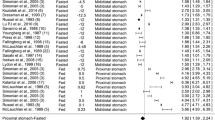Abstract
The oral delivery of peptidic drugs is problematic because of their degradation in the gastrointestinal tract and low absorption through the intestinal mucosa. Earlier in vitro studies with two series of digestion-resistant, radiolabeled peptides that varied in physical properties (molecular weight, lipophilicity, and hydrogen bonding sites) had suggested that intestinal transport of these peptides was most influenced by the number of hydrogen bonding sites, the major determinant of desolvation energy. To determine whether this correlation could be confirmed in vivo, intestinal absorption was determined by comparing the biliary and urinary recovery of these radiolabeled peptides in rats given intravenous or intraduodenal doses. Absorption was inversely correlated to the number of calculated hydrogen bonding sites for the model peptides, similar to what had been found in vitro. Clearance by liver and kidneys appeared to be unaffected by desolvation energy but was well correlated with lipophilicity.
Similar content being viewed by others
REFERENCES
W. D. Stein. The Movement of Molecules Across Cell Membranes, Academic Press, New York, 1967, pp. 65–91.
J. M. Diamond and E. M. Wright. Molecular forces governing nonelectrolyte permeation through cell membranes. Proc. Roy. Soc. B 172:273–316 (1969).
R. A. Conradi, A. R. Hilgers, N. F. H. Ho and P. S. Burton. The influence of peptide structure on transport across epithelial cells I. Pharm. Res., 8:1453–1460 (1991).
A. Leo, C. Hansch, and D. Elkins. Partition coefficients and their uses. Chem. Rev. 71:526–616 (1977).
V. Austel and E. Kutter. In J. G. Topless (ed.), Quantitative Structure-Activity Relationships of Drugs, Academic Press, New York, 1983, pp. 437–496.
K. R. Buttleworth and D. Pelley. Mesenteric venous blood sampling in vivo in the rat. J. Physiol. 232:60P–61P (1973).
J. R. Weeks and J. D. Daves. Chronic intravenous cannulas for rats. J. Appl. Physiol. 19:540–541 (1964).
P. R. Bevington. Data Reduction and Error Analysis for the Physical Sciences, McGraw-Hill, New York, 1968, p. 56.
G. Maurer. Metabolism of cyclosporine. Transplant. Proc. 17 (Suppl. 1):19–26 (1985).
G. G. Nys and R. F. Rekker. The concept of hydrophobic fragmental constants (f-values). II. Extension of its applicability to the calculation of lipophilicities of aromatic and heteroaromatic structures. Eur. J. Med. Chem. 9:361–375 (1974).
D. W. Powell. Barrier function of epithelia. Am. J. Physiol. 241:G275–G288 (1981).
I. J. Hidalgo, T. J. Raub, and R. T. Borchardt. Characterization of the human colon carcinoma cell line (Caco-2) as a model system for intestinal epithelial permeability. Gastroenterology 96:736–749 (1989).
Author information
Authors and Affiliations
Rights and permissions
About this article
Cite this article
Karls, M.S., Rush, B.D., Wilkinson, K.F. et al. Desolvation Energy: A Major Determinant of Absorption, But Not Clearance, of Peptides in Rats. Pharm Res 8, 1477–1481 (1991). https://doi.org/10.1023/A:1015882030289
Issue Date:
DOI: https://doi.org/10.1023/A:1015882030289




